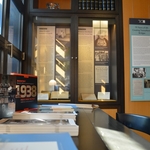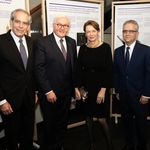Between Memory and Oblivion—The Jewish Cemeteries in Vienna

- Author
- Tim Corbett
- Date
- Tue, Jun 14, 2016
It is early afternoon in late summer in one of Vienna’s old Jewish cemeteries. The trees rustle in the breeze, muffling the distant rumble of urban commotion. Footsteps crackle in the spring undergrowth growing wildly around partly submerged, musty old tombstones. Golden sunbeams pierce through the leafy green canopy, dancing off the weathered inscriptions, illuminating arcane Gothic and Hebrew scripts—forgotten words from long ago. Up ahead, the pathway disappears into a distant floral vanishing point, framed by imposing structures of hewn rock. Grand yet dilapidated, the weight of time shows on the cracked marble faces.
This idyllic representation is neither arbitrary nor unusual. This is, to be sure, one of the faces these cemeteries adopt on sleepy, sunny afternoons, as the world rushes by, oblivious, outside the old cemetery walls. More significantly, however, this is how Vienna’s Jewish cemeteries are often portrayed in Austrian media. It is reflective, by subtle inference, of how Austria chooses to remember its Jewish past—while forgetting the desecrations wrought upon the cemeteries in the course of the Nazi cultural genocide. One history of the Vienna Central Cemetery mentions the “clear space where until very few years ago the beit tahara [ritual funerary home] stood,” without mentioning that it was blown up by Nazi thugs and their Viennese hangers-on during the November Pogrom (Havelka, 1985:57). Another claims that the Jewish cemeteries “survived the catastrophe of the Holocaust as though through a miracle.” It thereby characterizes both the Shoah and the partial survival of these spaces—with no mention of the severity of their desecration—in naturalistic terms which obfuscate the destructive agency of local Austrians (Bauer, 2004:216). Vienna’s crumbling Jewish cemeteries, sites of profound cultural gravitas fallen victim to decades of neglect, are frequently romanticized by non-Jewish Austrians as picturesque sites, “like an overgrown garden which visualizes the evanescence of all earthly things” (Barta, 2000:37).
For Harvey Fireside, known as Heinz Wallner before he was forced to flee the country of his birth at only eleven years of age, this forlorn vista is not a sight of mystical beauty. It is a visceral manifestation of violence and neglect. Fireside returned for the first time after sixty years of exile in September 2000. The trip, organized by the Jewish Welcome Service in Vienna, included a visit to one of the Jewish cemeteries. “We could see others in our group walking by gravestones, many of which were lying on the ground or tilted at odd angles,” he recalled. “High weeds made it difficult to decipher the markers. It was a disheartening sight.” In Fireside’s mind, the weathered face of the cemetery was nothing less than the embodiment of a society that had chosen to forget: “The frustration of this visit still rankled: a morning of stumbling through an unkempt jumble of decaying gravestones covering old bones. Couldn’t the Viennese, with their compulsive neatness, tidy up the place?” (Harvey Fireside, “Visit to a Viennese Cemetery”, unpublished memoir, 2004, LBI, ME 1486).
Vienna’s Jewish cemeteries are the most profound memorials to the long but anfractuous history of Jewish life, culture, and community surviving in the present cityscape. Vienna is today regarded as one of the cradles of modern culture, and the role of Jews in the genesis of Viennese culture has been the focus of intense interest in recent decades. Vienna’s Jewish cemeteries testify to the profound enmeshment but also the conflicts of Jewish life within Viennese society reaching from the Middle Ages right into the present day. They stand at the nexus of Vienna’s Jewish history. The sites reflect the development of complex codes of belonging and (self-)representation located within the interaction of the Jewish community with Viennese society and Austrian polity. This process was driven by change and innovation on a multitude of levels. It affected and reflected issues of religiosity, economy, class, gender, profession, and education, among others. At the same time, the development was continuously drawing on, sustaining, advancing, or contesting Jewish sepulchral traditions. The consequence was a unique yet multifarious Jewish-Viennese sepulchral culture. Therein, the cemeteries became a principle locus of the negotiation of ‘Jewish’ and ‘Viennese’ or ‘Austrian’ cultures and of the challenges which these continuously evolving categories posed to individual and communal codes of belonging.
No integrated history of Vienna’s Jewish cemeteries exists to date, though some works on specific cemeteries have appeared sporadically (most notably Steines, 1993; Veran, 2002; and Walzer, 2011). The origins of the Jewish cemeteries as communal spaces, and the over 100,000 grave-memorials located therein, are material artifacts of enormous cultural and historical significance. To date, they have not been subjected to sustained analysis. Their textual-semiotic encoding with a matrix of profound (self-)representations evinces the increasing enmeshment of the Jewish community, or at least segments of it, within Viennese society. This was, however, accompanied, by a deep social fragmentation resulting in a profound blurring of lines between ‘Jewish’ and ‘Austrian’, or between ‘Jewish’ and ‘non-Jewish’.
A characteristic example is the honorary grave-memorial of Leopold Kompert, the Bohemian-born progenitor of ‘ghetto literature’, located in Section 5B, Row 1, Plot 2 of the older Jewish section of Vienna’s Central Cemetery. This reads in German: “PhD, imperial and royal government councilor. Citizen and city councilor of the City of Vienna. Lower Austrian state school councilor, representative of the Jewish community organization, knight of various orders etc.” Kompert’s epitaph represents a broad intersection of realms: academic, professional, political, communal, and noble. The multiplicity of belongings is underscored through the simple word ‘etc.’, an allusion to Emperor Franz-Joseph’s 119-word official title, which was punctuated throughout with ‘etc’. The epitaph further names Kompert simply but powerfully a ‘citizen of Vienna.’ This was a popular epithet amongst Viennese Jews in the late nineteenth century, representing their inclusion into Viennese civil society after centuries of ostracism.
Vienna’s Jewish cemeteries are some of the most potent sites for the construction, negotiation, and contestation of memory of Austria’s Jewish heritage, and all the profound achievements and ruptures associated therewith, to survive in the present cityscape. These sites evince the perennially powerful discourses concerning culture, community, and belonging both within the Jewish community and within Viennese and Austrian society that continue into the present day. They offer a compressed picture of a long and convoluted history defined through incessant vicissitude. Discontinuity and the successive ruptures of modern Austrian and Central European history are as characteristic of it as is the evident longevity and influence of Jews and Jewish culture within this history.
As Austria grapples today with its conflicted histories of cultural genesis and cultural genocide, faced with perennial issues of immigration and social change and the challenges these pose to the country’s social cohesion and national self-understanding, the city’s grand yet dilapidated Jewish cemeteries continue to exert a powerful presence in politics and society, as sites of negotiation and contestation of Jewish belonging in modern Austria and of the role and meaning of Austria’s Jewish history in the present day. These houses of death remain as some of the most significant betei hachaim, or houses of life. They testify to the life of Jews in Vienna, providing for Vienna’s Jews the mnemonic and physical link between the past and the present, here, in the “houses of their fathers’ sepulchers.”
WORKS CITED:
Barta, Franz-Josef. Der Wiener Zentralfriedhof: Ein Friedhof für alle Religionen. Vienna: MA43, 2000.
Bauer, Werner. Wiener Friedhofsführer: Genaue Beschreibung sämtlicher Begräbnisstätten nebst einer Geschichte des Wiener Bestattungswesens. Vienna: Falter, 2004.
Havelka, Hans. Zentralfriedhof. Vienna: Jugend & Volk, 1985.
Steines, Patricia. Hunderttausend Steine: Grabstellen großer Österreicher jüdischer Konfession auf dem Wiener Zentralfriedhof Tor I und Tor IV. Vienna: Falter, 1993.
Veran, Traude. Das Steinerne Archiv: Der Wiener jüdischer Friedhof in der Rossau. Vienna: Mandelbaum, 2002.
Walzer, Tina. Der jüdische Friedhof Währing in Wien: Historische Entwicklung, Zerstörungen der NS-Zeit, Status Quo. Vienna: Böhlau, 2011.
Tim Corbett is a Prins Foundation Postdoctoral Fellow at the Center for Jewish History in New York. His current project, entitled “Once the ‘Only True Austrians’: Jewish-Austrian Memory and Identity after the World Wars”, investigates interactive constructions of ‘Jewishness’ and ‘Austrianness’ through the 20th century, in particular drawing on the vast collection of memoirs of and interviews with Jewish Austrians held at the Leo Baeck Institute. His book on Vienna’s Jewish cemeteries, based on his 2015 dissertation, entitled Die Grabstätten meiner Väter: Die jüdischen Friedhöfe in Wien, will be published in Austria in 2018.
Latest News





